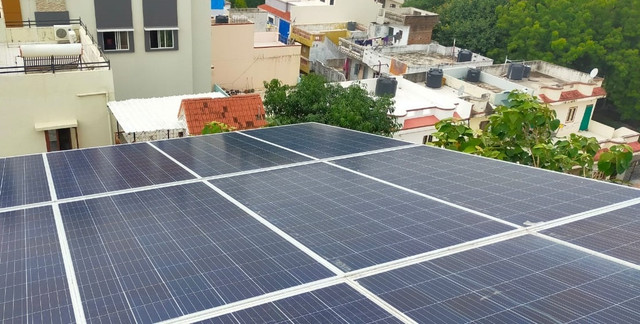
The Indian solar industry has witnessed remarkable growth over the past decade, driven by the government's ambitious renewable energy targets and favorable policies. As the world transitions towards cleaner and more sustainable energy sources, solar power has emerged as a key player in India's energy mix. However, with technological advancements and evolving market dynamics, questions have arisen about the future of polycrystalline solar modules in the Indian market.
Polycrystalline solar cells, often referred to as multi-crystalline or poly-Si, have been a predominant technology in the solar industry for many years. These cells are made from multiple crystals of silicon, which are less expensive to produce compared to their monocrystalline counterparts. However, they typically have lower efficiency rates and tend to degrade faster over time.
The Rise of Monocrystalline Modules
In recent years, monocrystalline solar modules have gained significant traction in the Indian market. These modules are made from a single, continuous crystal of silicon, resulting in higher efficiency and better performance over time. As manufacturers continue to improve their production processes and drive down costs, monocrystalline modules have become increasingly competitive in terms of price per watt.
According to industry reports, the demand for monocrystalline modules in India has surged, with many leading solar developers and installers opting for this technology over polycrystalline modules. The higher efficiency of monocrystalline modules translates into lower land requirements and reduced balance of system (BOS) costs, making them an attractive choice for large-scale solar projects.
Shift Towards High-Efficiency Technologies
The Indian solar industry is not only witnessing a shift towards monocrystalline modules but also embracing other high-efficiency technologies, such as bifacial modules and half-cut cell modules. Bifacial modules can generate electricity from both sides, increasing energy yield, while half-cut cell modules reduce resistive losses and improve performance in shaded or high-temperature conditions.
These advanced technologies offer significant advantages in terms of energy generation and overall system performance, further driving the demand for high-efficiency solutions. As the Indian market matures and becomes more competitive, developers and installers are increasingly focused on maximizing energy output and minimizing the levelized cost of energy (LCOE).
Government Initiatives and Policy Support
The Indian government has played a pivotal role in shaping the solar industry's landscape through various initiatives and policy measures. The Production Linked Incentive scheme (PLI) aims to promote domestic manufacturing of high-efficiency solar photovoltaic (PV) modules, including monocrystalline and bifacial modules.
Furthermore, the Ministry of New and Renewable Energy (MNRE) has introduced performance-based incentives and quality control measures to encourage the adoption of high-efficiency technologies. These policies not only support domestic manufacturing but also create a conducive environment for the deployment of advanced solar solutions.
Environmental and Sustainability Considerations
Beyond economic and technological considerations, environmental considerations are also driving the shift towards monocrystalline and high-efficiency modules. These modules typically have a higher energy yield per unit area, reducing the overall land footprint required for solar projects. Additionally, they contribute to lower carbon emissions over their lifetime, aligning with India's commitment to sustainable development and climate change mitigation.
However, it is essential to note that the manufacturing processes of monocrystalline modules and other high-efficiency technologies may have a higher initial environmental impact compared to polycrystalline modules. Therefore, it is crucial for manufacturers to adopt sustainable practices and prioritize renewable energy sources in their production facilities to minimize the overall environmental footprint.
The Future of Polycrystalline Modules in India
While the demand for monocrystalline and high-efficiency modules is on the rise, it is unlikely that polycrystalline modules will be completely phased out in the near future. Polycrystalline technology still holds its place in certain market segments, particularly in residential and small-scale commercial installations, where cost considerations may outweigh the need for maximum efficiency.
Furthermore, as the Indian solar industry continues to grow and evolve, there may be opportunities for polycrystalline module manufacturers to innovate and improve their products' performance and cost-effectiveness. Advancements in cell architecture, module design, and manufacturing processes could potentially revive the competitiveness of polycrystalline modules in specific applications.
Conclusion
The Indian solar industry is undoubtedly witnessing a shift towards monocrystalline and high-efficiency module technologies, driven by technological advancements, cost considerations, and environmental factors. However, the journey towards a sustainable and clean energy future requires a diversified approach where various technologies coexist and complement each other. While monocrystalline and other advanced module technologies are expected to dominate the market in the coming years, polycrystalline modules may continue to serve niche segments. Ultimately, the decision to adopt a particular technology will depend on project-specific requirements, cost-benefit analyses, and evolving market dynamics.
At Waaree, a leading Indian solar company, we are at the forefront of this technological revolution. With a strong commitment to innovation and sustainability, we offer a comprehensive range of solar solutions, including high-efficiency monocrystalline and bifacial modules. Explore our cutting-edge technologies and stringent quality products at shop.waaree, empowering our customers to harness the full potential of solar energy while contributing to a greener and more sustainable future for India.



